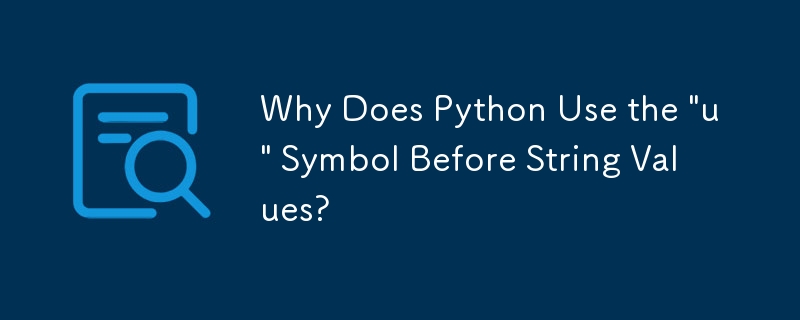

Why the 'u' Symbol Precedes String Values
When you encounter the 'u' symbol before string values in your Python script, it signifies Unicode strings. Unicode is a comprehensive character encoding standard that extends beyond the limitations of ASCII, enabling the representation of a wider range of characters.
In Python 2, the 'u' prefix distinguishes Unicode strings from regular strings. This distinction is absent in Python 3, where Unicode strings are the default.
Unicode Representation
Unicode allows for the representation of characters from different languages and symbols. For instance:
<code class="python">val = u'Ознакомьтесь с документацией'</code>
This Unicode string stores Russian characters, effectively allowing you to embed non-English characters in your code.
Unicode Compatibility
In Python 2, Unicode and non-Unicode strings behave similarly. For example:
<code class="python">bird1 = unicode('unladen swallow')
bird2 = 'unladen swallow'
bird1 == bird2 # True</code>However, this interchangeability is not guaranteed in Python 3. In Python 3, you must explicitly distinguish between Unicode strings and byte strings, using prefixes such as 'u' for Unicode and 'b' for bytes.
Additional Symbols
Besides the 'u' symbol, you may encounter other special characters in Python strings:
Example
<code class="python">'foo\"' # Regular string with interpreted backslashes r'foo\"' # Raw string with literal backslashes</code>
The above is the detailed content of Why Does Python Use the \'u\' Symbol Before String Values?. For more information, please follow other related articles on the PHP Chinese website!
 What is the use of java
What is the use of java
 Domestic Bitcoin buying and selling platform
Domestic Bitcoin buying and selling platform
 psrpc.dll not found solution
psrpc.dll not found solution
 Three mainstream frameworks for web front-end
Three mainstream frameworks for web front-end
 The difference between indexof and includes
The difference between indexof and includes
 How to calculate the factorial of a number in python
How to calculate the factorial of a number in python
 Computer system vulnerability repair methods
Computer system vulnerability repair methods
 How to solve the problem of access denied when booting up Windows 10
How to solve the problem of access denied when booting up Windows 10
 Latest ranking of digital currency exchanges
Latest ranking of digital currency exchanges




